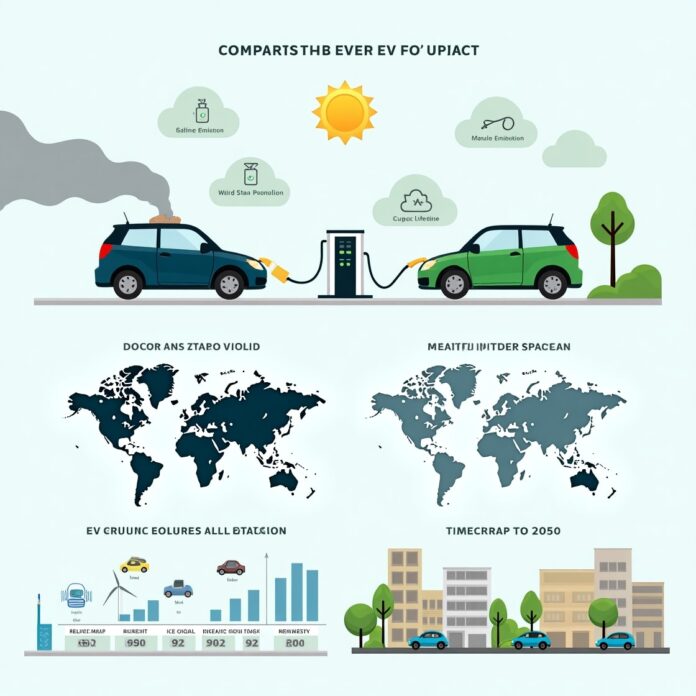Introduction
The worldwide concern about climate change has intensified efforts to reduce greenhouse gas emissions in a variety of industries, particularly in transportation, which is responsible for approximately 24% of global CO2 emissions (IEA, 2022). Electric vehicles (EVs) have emerged as a promising alternative to decarbonize transportation, despite the fact that vehicles powered by fossil fuels continue to be a significant contributor. EVs offer a pathway to reduce emissions, improve air quality, and transition toward sustainable energy. However, a number of factors, including consumer adoption, infrastructure, and sources of electricity generation, all impact their potential. This assignment explores whether electric vehicles can significantly reduce global carbon emissions by reviewing existing literature, examining emission sources, and evaluating real-world impacts.
Literature Review
Several studies have assessed the environmental impact of EVs compared to internal combustion engine vehicles (ICEVs). The life cycle assessment (LCA) of EVs was evaluated by Hawkins et al. (2013). They discovered that, despite the fact that EVs generate more emissions during manufacturing, particularly when battery production is involved, they generally produce less emissions over the course of their operational lifespan. Breetz et al. (2018) emphasized the importance of the energy mix used to charge EVs. In regions with high renewable energy penetration, the climate benefits are substantial. EVs, on the other hand, may only marginally improve conditions in coal-dependent regions. The International Energy Agency (IEA, 2021) reported that EV adoption must be paired with decarbonizing the power sector to meet net-zero goals. The agency projects that by 2030, EVs could avoid 1.5 gigatonnes of CO₂ annually, provided supportive policies and clean energy integration are implemented.
ICEVs vs. Emissions:
Understanding EVs
To assess the effectiveness of EVs in reducing global emissions, it’s crucial to compare their emissions at different stages:
1. Vehicle Manufacturing
Due to the energy-intensive manufacturing process of lithium-ion batteries, EVs typically generate more emissions during production than ICEVs. However, Ellingsen et al. (2016) argued that, particularly in regions with clean electricity, operational savings offset the higher manufacturing emissions within a few years of use.
2. Operational Emissions
Unlike gasoline or diesel vehicles, EVs emit zero tailpipe emissions. However, their total operational emissions depend on the electricity source. In countries like Norway or Canada, where hydropower is prevalent, EVs contribute almost no carbon emissions. In contrast, countries with coal-heavy grids, such as India or Poland, still see significant emissions from EV use, although typically lower than those from ICEVs (OECD, 2020).
3. Recycling and End-of-Life
Recycling and disposing of batteries are upcoming obstacles. However, advancements in battery reuse and materials recovery (e.g., from Tesla and Redwood Materials) show potential to reduce lifecycle emissions even further (Gaines et al., 2018).
Potential for Emission Reduction
1. Global Carbon Emission Mitigation
Emissions from the transportation industry could significantly decrease if EVs replace conventional vehicles on a large scale. According to Transport & Environment (2020), electric cars in Europe emit three times less CO₂ than ICEVs over their lifetime, including battery production. According to the IEA’s Sustainable Development Scenario, if the global adoption of EVs reaches 60% by 2050, it could reduce cumulative emissions by up to 10 gigatonnes, making a significant contribution to keeping global warming below 2°C (IEA, 2021).
2. Air Quality Improvement
Not only do electric vehicles cut down on CO2, but they also cut down on nitrogen oxides (NOx) and particulate matter (PM), two important pollutants that can cause respiratory problems. Cities like Los Angeles, Beijing, and Delhi, which struggle with air pollution, could benefit immensely from widespread EV usage (UNEP, 2020).
Barriers and Challenges
EVs are not a panacea, despite their potential. Several challenges hinder their global effectiveness in reducing emissions:
1. Clean Power Grids
In many developing countries, electricity is generated using coal or natural gas. In such contexts, shifting to EVs without greening the grid could lead to only modest emissions savings—or, in some cases, even increases (Holland et al., 2016).
2. Limited Access and High Initial Costs In many markets
EV prices remain high, and rural and low-income areas still lack a sufficient charging infrastructure. This limits large-scale adoption, especially in emerging economies where transportation demand is growing fastest.
3. Battery Mining and Environmental Impact
The extraction of lithium, cobalt, and nickel for EV batteries raises environmental and ethical concerns. Mining operations often have large carbon footprints, disrupt ecosystems, and involve labor rights violations (Amnesty International, 2019). To ensure that EVs will have a positive impact on the environment as a whole, ethical supply chains and sustainable sourcing must be developed.
Strategies for Maximizing Emission Reduction
To unlock the full climate benefits of EVs, a multi-pronged approach is necessary:
• Decarbonizing the Grid:
Using renewable energy sources ensures that EVs run on clean electricity.
• Enhancing Battery Technology:
Developments in solid-state batteries and recycling can help cut down on emissions from production.
• Government Policies:
Incentives, subsidies, and strict emission regulations can drive EV adoption.
• Urban Planning and Public Transport Integration:
EVs should complement broader sustainable mobility strategies.
Future Prospects
The future of EVs appears promising. EVs are becoming increasingly feasible as a result of falling battery costs, improved infrastructure, and government support. By 2040, EV sales could account for over half of all new car sales worldwide, according to Bloom berg NEF (2023), potentially reducing transportation emissions by more than 30%. Emerging technologies, such as vehicle-to-grid (V2G) systems, allow EVs to return power to the grid, increasing renewable energy integration and stabilizing energy supply (Lund & Kempton, 2008). Furthermore, developments in shared and autonomous electric vehicles (EVs) have the potential to alter urban transportation while simultaneously lowering emissions per capita.
Conclusion
When used in conjunction with sustainable manufacturing practices and clean energy sources, electric vehicles have the potential to significantly reduce global carbon emissions. While not without challenges such as battery production impacts, dirty electricity grids, and limited access in developing countries EVs represent a vital tool in the fight against climate change. Their effectiveness hinges on systemic changes in energy, policy, infrastructure, and consumer behavior. Electric vehicles (EVs) have the potential to play a significant role in meeting global climate goals and serve as a foundation for a future low in carbon.
References
• Amnesty International. (2019). This is what we die for: Human rights abuses in the Democratic Republic of the Congo power the global trade in cobalt.
• Breetz, H. L., Mildenberger, M., & Stokes, L. C. (2018). The political logics of clean energy transitions. Business and Politics, 20(4), 492–522. https://doi.org/10.1017/bap.2018.11
• BloombergNEF. (2023). Electric Vehicle Outlook 2023. https://about.bnef.com
• Ellingsen, L. A., Singh, B., & Strømman, A. H. (2016). The size and range effect: Lifecycle greenhouse gas emissions of electric vehicles. Environmental Research Letters, 11(5), 054010.
• Gaines, L., Nelson, P., & Sullivan, J. (2018). Battery recycling and life cycle analysis. The Electrochemical Society Interface, 27(1), 63–67.
• Hawkins, T. R., Singh, B., Majeau-Bettez, G., & Strømman, A. H. (2013). Comparative environmental life cycle assessment of conventional and electric vehicles. Journal of Industrial Ecology, 17(1), 53–64.
• Holland, S. P., Mansur, E. T., Muller, N. Z., & Yates, A. J. (2016). Are there environmental benefits from driving electric vehicles? The Economic Journal, 126(594), 1–30.
• IEA. (2021). Global EV Outlook 2021. International Energy Agency. https://www.iea.org/reports/global-ev-outlook-2021
• IEA. (2022). CO₂ emissions in 2021. https://www.iea.org/reports
• Lund, H., & Kempton, W. (2008). Integration of renewable energy into the transport and electricity sectors through V2G. Energy Policy, 36(9), 3578–3587.
• OECD. (2020). Evaluating the climate impacts of electric vehicles. OECD Environment Working Papers.
• Transport & Environment. (2020). Electric cars emit three times less CO₂ than equivalent petrol cars. https://www.transportenvironment.org
• UNEP. (2020). Electric mobility: Taking off in Africa. United Nations Environment Programme.


